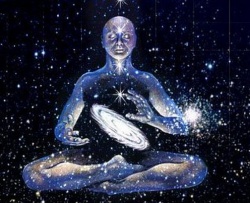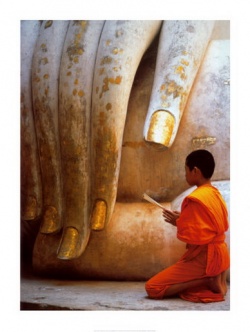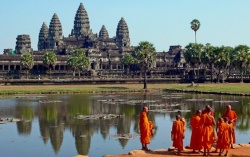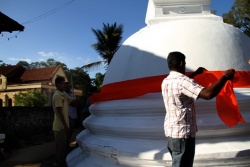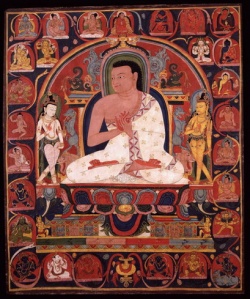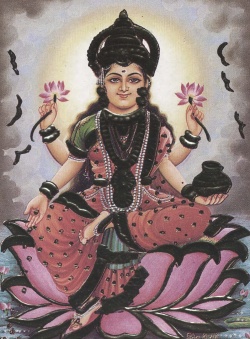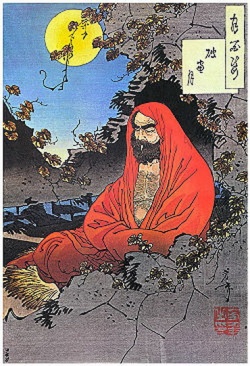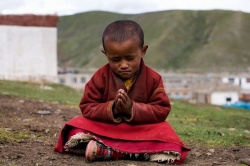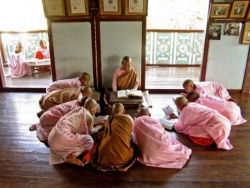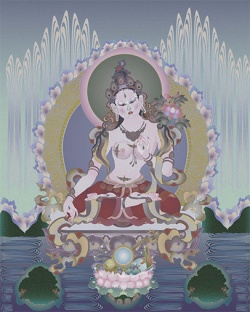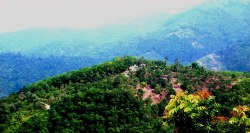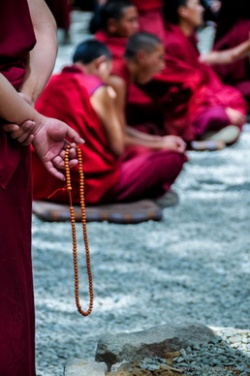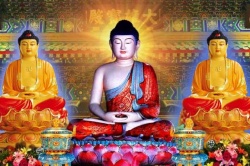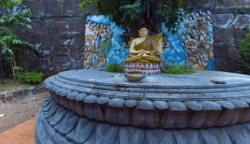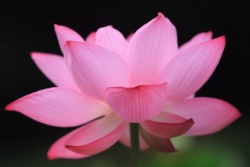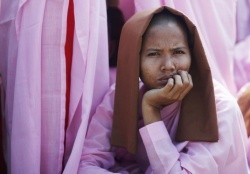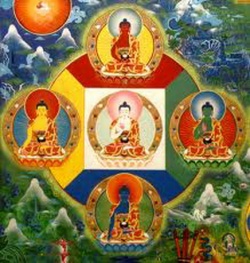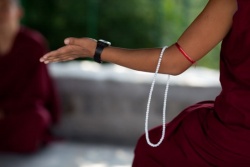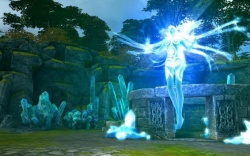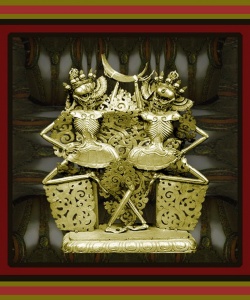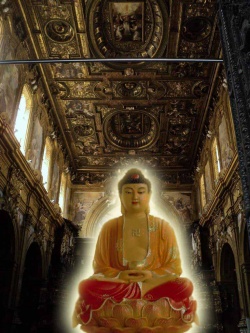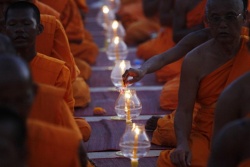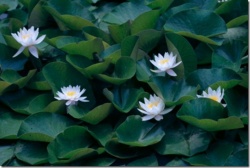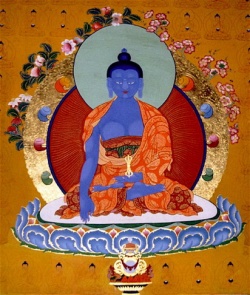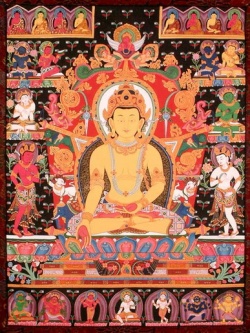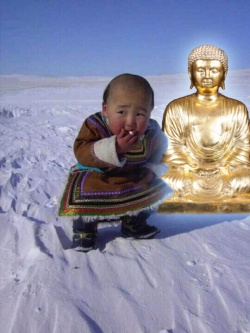The Mūlasarvāstivādins of Mathura
There are two main reasons why the Mūlasarvāstivāda school is important.
The first reason is that it has left a large literary heritage, which is growing since many of the Sanskrit fragments discovered recently may possibly be from this school.
The second reason is that the Tibetan Sangha owes its Vinaya lineage to this school.245
It is important, then, to understand the place of the Mūlasarvāstivādins in Buddhist history.
Unfortunately, this is far from clear.
The name Mūlasarvāstivāda is not found in any early inscriptions, and cannot be definitely attested until the later period of Indian Buddhism.
Their Vinaya is extensive, and most modern scholars have tended to see it as late.
In its current form it should be assigned to the ‘middle period’ of Indian Buddhism—between 500‑1000 years AN—and the vagueness of this ascription tells us how little we know.
Nevertheless, some scholars have claimed that it shows signs of early features in some respects.
This should not surprise us, as the whole has evidently been amassed over a vast period of time, and must incorporate material from greatly different eras.
If we are to ascribe the earliest features, such as the pāṭimokkha, to the Buddha himself, and the latest additions to, say, 500 CE, we are talking of a 1000 year period of composition!
The uncertainty around this school has fuelled a number of hypotheses.
Frauwallner’s theory is that the Mūlasarvāstivāda Vinaya was the disciplinary code of an early Buddhist community based in Mathura, which was quite independent as a monastic community from the Sarvāstivādins of Kaśmir (although of course this does not mean that they were different in terms of doctrine).
Lamotte, against Frauwallner, asserts that the Mūlasarvāstivāda Vinaya was a late Kaśmīr compilation made to complete the Sarvāstivādin Vinaya.246
Warder suggests that the Mūlasarvāstivādins were a later development of the Sarvāstivāda, whose main innovations were literary, the compilation of the large Vinaya and the Saddharmasmṛtyupasthāna Sūtra,247 which kept the early doctrines but brought the style up to date with contemporary literary tastes.248
Enomoto pulls the rug out from all these theories by asserting that Sarvāstivādin and Mūlasarvāstivādin are really the same.
Meanwhile, Willemen, Dessein, and Cox have developed the theory that the Sautrantikas, a branch or tendency within the Sarvāstivādin group of schools, emerged in Gandhāra and Bactria around 200 CE.
Although they were the earlier group, they temporarily lost ground to the Kaśmīr Vaibhāśika school due to the political influence of Kaṇiṣka.
In later years the Sautrantikas became known as the Mūlasarvāstivādins and regained their earlier ascendancy.249
I have elsewhere given my reasons for disagreeing with the theories of Enomoto and Willemen et al.250 Neither Warder nor Lamotte give enough evidence to back up their theories.
We are left with Frauwallner’s theory, which in this respect has stood the test of time.
For the remainder of this chapter I am mainly concerned with drawing out the implications of this theory.
However, since this particular scenario is controversial, I will also examine another possibility.
If Frauwallner is wrong, and the Sarvāstivādins and Mūlasarvāstivādins are not derived from separate Vinaya communities, it would then be likely that they are related to each other in some way.
Perhaps the same school maintained different textual recensions of the Vinaya while remaining unified in practical matters.
In this case we should seek for the origins of the Mūlasarvāstivāda in relation to the origins of the Sarvāstivāda. This possibility is examined at the end of this chapter.
But starting off with Frauwallner, the gist of his theory is this.
The Mūlasarvāstivādin Vinaya includes a section telling of the Buddha’s trip to Kaśmīr, prophesying the conversion by Majjhantika.
However, this section has been arbitrarily inserted in the text, showing that it is a later interpolation.251
The earlier portions point to a connection with Mathura.
This argument has recently been restated by Wynne, who defends Frauwallner’s thesis, and adds the suggestion that the Mathura community later moved to Kaśmīr, where they came into conflict with the Vaibhāśikas over who could claim to be the ‘real’ Sarvāstivādins.252
Thus Frauwallner’s theory holds that the Mūlasarvāstivāda Vinaya is the disciplinary code of a Buddhist community based in Mathura. A key piece of evidence is the statement by Kumārajīva in his translation of the Mahāprajñāpāramitopadeśa:
‘(The Vinaya), in brief, contains eighty sections. It is of two kinds. The first is the Vinaya of Mathura, which includes the Jātaka and Avadāna, and comprises eighty sections.
The second part, the Vinaya of Kaśmīr, has excluded the Jātaka and Avadāna;253 accepting only the essentials, it forms ten sections. There is, however, a commentary (vibhāṣā) in eighty sections which explains it.’254
The Mūlasarvāstivāda Vinaya is indeed extremely long, full of Avadānas and Jātaka stories, and has strong links with Mathura.
The Sarvāstivāda Vinaya, closely associated with Kaśmīr, is known as the ‘Ten Part Vinaya’, and does not contain the legendary and narrative material.
We are, then, justified in equating these two Vinayas with the Vinayas mentioned by Kumārajīva. Frauwallner notes significant differences between these two Vinayas, and would regard the Sarvāstivāda Vinaya as in many respects closer to the other missionary schools,
and probably springing from that source, while the Mūlasarvāstivāda Vinaya is an independent early lineage.
While not wishing to contest this, I have noticed that on occasion these two Vinayas do share specific features in common that suggest some connection.
Several sources make a further connection between the Vinaya and Upagupta, the great teacher of Mathura.255
As the last of the five ‘Masters of the Law’ who were accepted throughout the northern traditions, it is natural that Upagupta’s name shuld be connected with the Vinaya.
And we notice that one of the most persistent attributes of Upagupta is as a preacher of avadānas.
Indeed, so close is this connection that Strong has spoken of Upagupta as the patron of a class of monks who developed and preserved this literature.
It can hardly be a coincidence, then, that of all the Vinayas known to us, the only one that features the avadānas so strongly hails from the home town of the great Elder so closely associated with this class of literature.
9.1 Mathura in the Suttas
Mathura did not have an auspicious start as a Buddhist center.
The Anguttara Nikāya has the Buddha tersely remarking that in Mathura the roads are uneven, it is dusty, the dogs are fierce, the yakkhas are predatory, and alms-food is hard to get.256
The background for this event is given briefly in the Pali commentary, which says that when the Buddha visited Mathura, he was greeted by a naked yakkhinī, who tried to either terrify or seduce him (or more likely both), out of fear he would convert all her devotees.257
This episode is drawn out in full detail in the Mūlasarvāstivādin Vinaya, both in the Gilgit manuscripts258 and the Chinese, and appears to have become the source of a Mūlasarvāstivādin apologetic for Mathura, which I will briefly summarize.
The Buddha visited Mathura and was greeted by the Brahman householders, although they were initially suspicious because it was said he did not properly respect Brahmans. Nevertheless, he taught Nīlabhūti a lesson on the caste system and they were all converted.
That day was a festival day, and the Buddha was then challenged by the yakkhinī. It was after this episode that he spoke of the five disadvantages, similar to above.
Then he told the monks not to stay at Mathura, and left to stay at the Donkey-Monster Forest.
(The Pali tradition also knows a Gardabha yakkha: he was the doorkeeper of the famous yakkha Ālavaka, a childeating monster tamed by the Buddha.)
The brahmans of Mathura are anxious to feed the monks and secure their blessings, for they have been plagued by child eating259 yakkhas called Śara,260 Vana,261 and the yakkhinī Hārīka (訶梨迦).262
The Indic forms of the first two of these names equate with names found in the parallel passage in the Gilgit Mss as given by Strong.263
The final name is not equivalent to any of the names in the Gilgit Mss, but would seem very likely to be none other than the famous Hārītī, originally a goddess of smallpox in Rajagaha, who went on to have a glorious career in Buddhist popular culture, and indeed even thrives today in far off Japan.
The ogres come and sit in while the Buddha is teaching Dhamma, evidently intending to spoil the event, but the Buddha admonishes them and they are converted.
The townsfolk built 2500 monasteries, one for each of the 2500 yakkhas who have been converted.
We have noticed above that a certain goddess called Kuntī evidently has a family connection with Kotiputa, an early monk’s name recorded at Vedisa.
While the missions legend depicts Kuntī as a sweet woodlands nymph, elsewhere she takes on a more terrifying mien. The Mūlasarvāstivāda Vinaya shows her aspect as a vicious ogress who devours children.264
Other names recorded at Vedisa include Hāritīputa and Ālābagira. It now appears that all of these names are connected with child eating yakkhas: Hārītī, Kuntī, and Ālavaka.
There are more than a few links between the stories of Hārītī and Kuntī: they are in fact the same story with a few details changed to add local color.
The monasteries were named after the local yakkhas, implying an ongoing fusion between local deity cults and the establishment of Buddhist monasteries.
It is likely that the monasteries kept a shrine for the local deities that the villagers used for their traditional spirit worship cult.
The villagers, it seems, would offer their children to the monastery for a period of time, perhaps in substitute for a more primitive cult of child sacrifice.
Our next source, from the Pali canon, is set at a monastery called the Gundāvana, the ‘Gundā Grove’.265
Soon after the Parinibbana, the disciple Mahākaccāna taught the Madhura Sutta (MN 84/SA 548) to King Avantiputta while staying at the Gundāvana.
This discourse is a major statement on the invalidity of the caste system, and as such ties in neatly with the teaching to the Mathuran brahmans as depicted in the Mūlasarvāstivāda Vinaya.
Such early royal patronage would have formed a strong foundation for the later growth of the Dhamma there.
A century later, several of the accounts of the Second Council also mention Mathura (Mahīśāsaka, Sarvāstivāda, Mahāsaṅghika, though not Mūlasarvāstivāda).
One of the Elders at that Council is Śāṇavāsin, the preceptor of Upagupta, both of who are local saints of Mathura. Mathura, then, would have had a continuous occupation of Buddhist monks from the Buddha’s lifetime or shortly after.
The community at Mathura could thus rightly regard themselves as an original community. Nevertheless, they were far enough from the main early center around Pāṭaliputta to remain a little distant from the controversies.
While they were involved in the Second Council, this was the last time Buddhist monks from all districts gathered as one. There is no evidence that the Mathuran community took part in later Councils.
It is true that their Elder Upagupta is frequently said to have taught Aśoka, and might therefore have participated in the various discussions that occurred at that time.
But this is far from certain, and in any case, he would have done this as a visiting Elder, and this would not have directly affected the Mathuran Sangha.
None of the accounts of schisms and discussions after the Second Council mention Mathura.266 The ‘Unity Edicts’ follow the southern route well away from Mathura.
So it seems that the Mathuran community—perhaps like many others—did not participate directly in the early schismatic movements.
They developed their own scriptures, inspired by Upagupta’s style, and it seems plausible that some of the early Sarvāstivāda Abhidharma ideas may have emerged here, though this is purely speculative.
They are not referred to in the Mahāvihāravāsin account of the Third Council, not because they were in any sense heretical, but simply because they were an already established community who did not need missionizing.
In the early years there would, of course, be no need for this community to call itself by any sectarian name, since it was just another branch of the Buddhist Sangha. By the first century CE the name Sarvāstivāda appears in the Mathura region.
Much later the term Mūlasarvāstivāda came into use, perhaps when the Mathura community came into competition with the Vaibhāṣika Sarvāstivādins of Kaśmir and wished to assert their primacy.
There is no indication that Moggaliputtatissa used the term vibhajjavādin to exclude the Mathuran community that later became known as the Mūlasarvāstivādins.
In fact the opposite is true. We have noticed that the Mathuran Elder Śāṇavāsin lived on the Ahogaṅga/Urumuṇḍa mountain, some way out of the town.267
Before the Third Council, Moggaliputtatissa saw the troubles brewing in the capital of Pāṭaliputta, and so went to practice at the same Ahogaṅga/Urumuṇḍa mountain monastery founded by Śāṇavāsin, which was renowned as the foremost of all places for samatha meditation.
Moggaliputtatissa stayed on retreat there for seven years before reluctantly descending on the invitation of Aśoka to resolve the problems at the Third Council.268
Thus the Mathuran community, in the lineage of Śāṇavāsin, far from being schismatic, is the place Moggaliputtatissa would go on retreat to escape from the schismatic problems.
This is perfectly plausible as history, but it also creates Moggaliputtatissa’s mythos: by staying in the forest monastery frequented by the great meditation masters Śāṇavāsin and Upagupta, his charisma as a realized master is assured.
He shows this spiritual power to Aśoka when he descends from the Ahogaṅga monastery. Aśoka is convinced that he is the only monk capable of stabilizing Buddhism, and hence invites Moggaliputtatissa to preside at the Third Council.
In this way the spiritual charisma of the Mathuran forest lineage of Śāṇavāsin and Upagupta is crucial in enabling the purification of the Sangha and the establishment of the vibhajjavāda.
Obviously this was not, from a vibhajjavādin perspective, a schismatic community. At the time of the missions the Sangha of Mathura, whose Vinaya we now possess under the name of the Mūlasarvāstivāda, were clearly within the circle of the vibhajjavādins.
It is even possible that Moggaliputtatissa shared ordination lineage with Śāṇavāsin.
This possibility rests on the evident confusion between the similar names Soṇaka and Sāṇaka.
The similarity is not merely phonetic. He is named after the robe he was accustomed to wear (–vāsī), which was either made of hemp cloth (sāṇa–), or was of red color (soṇa–).269
The Sinhalese Vinaya and Abhidhamma lineages mention a Soṇaka, one of the five early Vinaya masters:
Upāli,
Dāsaka,
Soṇaka,
Siggava,
Moggaliputtatissa.270
In the chronicles and commentaries the same list of Vinaya masters becomes partially fused with the account of the Councils, although the two are textually distinct.
Soṇaka must have lived at the same time as Śāṇavāsin, for they are both connected with the reign of Kāḷaśoka.271
The Pali tradition says the Second Council was held under Kāḷaśoka’s patronage, and Śāṇavāsin participated in that Council according to all traditions, including the Pali.
This highlights a puzzling discrepancy: the Pali list of five Vinaya masters appears not to contain any of the Elders mentioned in the Second Council proceedings.
It is really unthinkable that the most serious Vinaya crisis in Buddhist history, where monks gathered from all the Buddhist regions, should not have included a contemporary Vinaya master.
There are inescapable similarities between the Soṇaka found in the southern and the Śāṇavāsin of the northern sources.
Table 9.1: Parallels between Soṇaka & Śāṇavāsin Soṇaka Śāṇavāsin Born in Kāsī,
45 AN Born in Rājagaha, soon after Nirvana
Merchant’s son Merchant’s son
When young, went on journey trading to Giribbaja (= Rājagaha). When young, went on journey trading overseas
Goes to Veḷuvana at 15 years of age, with 55 companions On return, goes to Veḷuvana
Sees Dāsaka, Upāli’s student, and gains faith Meets Ānanda and offers to hold 5-year festival
Goes forth with parents’ permission, becomes an arahant versed in the Tipitaka Goes forth, becomes arahant versed in the Tipitaka
I suggest that there were two separate narratives, one of the lineage of Elders, and one of the Second Council. In these, the same Elder might be known by different names.
These separate passages were later fused, with the lineage of teachers preceding the Council narrative in some cases (Dīpavaṁsa, Mūlasarvāstivāda Vinaya).
Thus in the Pali tradition the Soṇaka of the lineage becomes the Sambhūta Sāṇavāsin of the Second Council.
To corroborate this, the Mūlasarvāstivāda Vinaya is the only one of the Vinayas that directly combines the lineage of Elders with the Second Council. And there we find the name Śāṇaka 272 in the lineage, but Yang-dag skyes (= Sambhūta) in the Second Council.273
But this Sambhūta must be the Sambhūta Sāṇavāsin mentioned in the Pali.
It is thus clear that both the Chinese and Tibetan versions of this Vinaya call the same Elder by different names in the two contexts.
Similarly, where the Samantapāsādikā, in comparing Moggaliputtatissa’s work to the Theras of old, refers to Kassapa at the First Council and Yasa at the Second Council, the Sudassanavinayavibhāsā mentions Kassapa and Soṇaka.274
This is immediately before a mention of the five Vinaya-masters, so must mean the same person, i.e. Śāṇavāsin = Soṇaka.
In the account of the Second Council itself, however, we find 婆那參復多 (po-na can-fu-tuo),275 for Sāṇasambhūta or Sonasambhūta.
There is, therefore, good reason to think a similar confusion has happened in the Pali tradition, and that Soṇaka is really Sāṇavāsin.
Now, Soṇaka/Śāṇavāsin is of course the preceptor of Upagupta; but he is also the preceptor of Siggava,276 who in turn is Moggaliputtatissa’s preceptor.277 Thus, if our idea is correct, Moggaliputtatissa inherited the same ordination lineage as the Mūlasarvāstivādins of Mathura.
9.4 The dragons of Kaśmīr
Those scholars who are not prepared to accept the Mathuran origins of the Mūlasarvāstivāda usually look to to the Northwest, especially Kaśmīr, for the home of this school. In this case we need to return to the missions accounts for information.
After the settling of the problems in the Sangha at the Third Council, Moggaliputtatissa decides that Buddhism would become well established in the border regions, and sends out missionaries across India.
One of these is Majjhantika, who is sent to Kaśmīr, where he subdues a host of dragons and establishes the Dhamma. Dīpavaṁsa 7.3 sums up:
Majjhantika the great sage, having gone to Gandhāra,
Inspired the ferocious dragon and freed many from bondage.’
This Majjhantika is not regarded in any way as heretical. In fact he is the ordination teacher of Mahinda, the revered founder of Sinhalese Buddhism.
This is mentioned in the commentarial accounts, and confirmed in the Dīpavaṁsa.278 While the missionary story is, in general, mainly known from the southern sources, in this case there is one Chinese text that says that Majjhantika and Mahinda were told by Ānanda himself to go to, respectively, Kaśmīr and Sri Lanka.279
In addition the Mahākarmavibhaṅga, describing missionary work by arahants of the Buddha’s day, mentions Madhyandina subduing the dragons of Kaśmīr, and Mahendra overcoming of the Rakṣasas of Siṁhaladvīpa.280 Thus the northern and southern sources are in perfect agreement.
Kaśmīr became the main centre for the Sarvāstivādins, so the story of Majjhantika recurs throughout the Sarvāstivādin influenced literature, including the Aśokarājasūtra,281 Mūlasarvāstivādin Vinaya,282 etc.
There is evidently a problem in seeing a patriarch of the Sarvāstivādins as one of the fathers of the Mahāvihāravāsin school.
Thus Wynne 283 suggests Majjhantika was a follower of the vibhajjavāda who converted to Sarvāstivāda after arrival in Kaśmīr.
But this scenario depends on the underlying assumption that sarvāstivāda and vibhajjavāda are opposing schools. In fact, there is no reason why Majjhantika should not have held opinions which we know of as sarvāstivādin while still in Pāṭaliputta,
but these were not felt at the time to lie outside the spectrum of acceptable views; or perhaps he had no decided view on that point at that time; or perhaps he never held sarvāstivādin views but was tolerant of his followers who did; and so on.
The point is that we don’t have to think in terms of mutually opposing schools in such a complex and fluid situation.
The internal evidence of the Sarvāstivādins themselves suggests that the ‘all exists’ (sarvam asti) doctrine emerged after the Aśokan period.
There is a famous passage, found throughout the Sarvāstivādin texts,284 containing a well known list of teachers giving their views on the ‘all exists’ doctrine.
Frauwallner notes that all the views in this passage differ from the mature position of the school, and the passage seems to be included in the Vibhāṣā as a ‘doxographical appendix’.
Thus it would seem to pre-date the compilation of the Vibhāṣā.
It mentions the following teachers:
after presenting his three lists of schools, suggests, as another explanation of the schisms, that the arising of the schools was due to the diversity of opinions by these masters.285
It seems we must regard these teachers as the developers of the ‘all exists’ doctrine, and none of them appear in the names we find mentioned in the Mauryan period.
This is confirmed in the San Lun Xuan Yi, a treatise written by Jia-xiang.
In accounting for the appearance of the Mahāsaṅghikas he follows the account of the Mahāvibhāṣā.
When it comes to the Sthaviras, he says that in the first 200 years there was the succession of teachers:
From Kassapa to Mecaka was 200 years, during which period there was no schism.286 At the beginning of the third century, Kātyāyanīputra passed away, and there was a split into two schools, Sthaviras and Sarvāstivādins.
Since Pūrṇa, there had been a gradual drifting away from the essentials, especially an excessive promotion of Abhidhamma over the Suttas. To escape the controversy, the Sthaviras went to the Himalayan region, and henceforth were called the Haimavatas.287
This account matches well with the picture we have drawn from the Pali sources. Both Moggaliputtatissa and Pūrṇa are separated from the Second Council by one ‘generation’ in the lineages, which puts them as approximate contemporaries around the time of Aśoka.
The connection between Moggaliputtatissa and the Abhidhamma is central to his identity: not only does he compose the core of the Kathāvatthu, but his first interest in investigating Buddhism is sparked by hearing a cryptic Abhidhamma phrase from the Cittayamaka, described as the ‘Buddhamantra’.
So around the time of Aśoka these monks were participating in the formal investigation, classification, and clarification of the teachings from the Suttas.
But only a couple of generations later, after the time of Kātyāyanīputra, did this result in a schism.
This description of a long period of gestation and discussion, eventually resulting in division, is far more plausible than the more radical accounts of instant schism.
245 Certain Japanese monastics also follow this Vinaya. See CLARKE, ‘Miscellaneous Musings on Mūlasarvāstivāda Monks.’
246 Lamotte, History of Indian Buddhism, 178.
247 T № 721, T № 722, T № 728.
248 WARDER, 393–394.
249 Charles Willemen, xi–xiii.
250 Sujato, A History of Mindfulness, chapter 17, note 32.
251 Frauwallner, The Earliest Vinaya and the Beginnings of Buddhist Literature, 28–36.
252 WYNNE, 29ff.
253 Stories concerning deeds done in past lives and their fruits in the present.
254 T25, № 1509, p. 756, c2–6.
255 Lamotte, History of Indian Buddhism, 175–176.
256 Aṅguttara Nikāya 5.220.
257 Aṅguttara Aṭṭhakathā 2.646.
258 Gilgit Mss. 3, pt. 1:14–15.
259 我等所生孩子。皆被侵奪 (T24, № 1448, p. 43, c2).
260 池 chi, pond.
262 T24, № 1448, p. 42, c7–p. 43, c18.
263 STRONG, The Legend and Cult of Upagupta, 6.
264 STRONG, The Legend and Cult of Upagupta, 34–37.
265 Although yakkhas are not mentioned, the similarity between this name (v.l. Kundavana) and Kuntī/Konta, etc., is noteworthy, given the connections between these stories.
266 I have earlier suggested that the Śāriputraparipṛcchā could have originated in a dispute in Mathura; but if this tentative hypothesis is true, it refers to a later period.
267 Pali Vinaya 2.298: Tena kho pana samayena āyasmā sambhūto sāṇavāsī ahogaṅge pabbate paṭivasati.
268 Samantapāsādikā 1.53.
269 Variation between these forms can occur even within different recensions of the same text. Thus Mukhopadhyaya’s edition of the Aśokāvadāna (on GRETIL) refers to Śāṇakavāsī, while the Nepalese manuscript of the same text has Soṇavāsī (according to Mitra, Sanskrit Buddhist Literature, pg. 10).
270 This list is found in the late canonical Parivāra (5.1), where it begins an extended list of Vinaya masters encompassing several centuries of transmission in Sri Lanka.
271 Dīpavaṁsa 4.52.
272 奢搦迦 (T24, № 1451, p. 411, b18). I cannot identify the exact form used for Śāṇavāsin in the Second Council, but it is certainly not the same. The nearest I can identify by comparison with Rockhill’s Tibetan rendering it should be 善見 (T24, № 1451, p. 413, b19), but this is rather Sudassana.
273 Rockhill, 170, 176.
274 須那拘 (T24, № 1462, p. 684, b13). In the first mention of the Vinaya masters it is spelt 蘇那拘 (T24, № 1462, p. 677, b19–20).
275 T24, № 1462, p. 678, a24.
276 Samantapāsādikā 1.235: Upālitthero sammāsambuddhassa santike uggaṇhi, dāsakatthero attano upajjhāyassa upālittherassa, soṇakatthero attano upajjhāyassa dāsakattherassa, siggavatthero attano upajjhāyassa soṇakattherassa, moggaliputtatissatthero attano upajjhāyassa siggavattherassa caṇḍavajjittherassa cāti. Sudassanavinayavibhāsā: 陀寫俱從優波離受。須提那俱從陀寫俱受。悉伽婆從須那 俱受。目揵連子帝須從悉伽婆受。又栴陀跋受。如是師師相承乃至于今 (T24, № 1462, p. 716, c26–29).
277 The story of Siggava, in response to a prophecy, intentionally visting Moggaliputtatissa’s parents’ house for alms for seven years before finding success closely echoes the story of Śāṇavāsin, in response to a prophecy, visting Upagupta’s family home for many years before finding success.
278 Dīpavaṁsa 6.25: Tato mahido pabbajito moggaliputtassa santike/Pabbājesi mahādevo majdhanto upasampade.
279 T № 1507, p.37, b16–27; see LAMOTTE, History of Indian Buddhism, 303.
280 The Pali sources agree that old Sri Lanka was overrun by demons, e.g. Dīpavaṁsa 1.20.
281 T № 2043; see RONGXI, 122–124.
282 ROCKHILL, 167–170.
283 WYNNE, 32.
284 See FRAUWALLNER, Studies in Abhidharma Literature, 185ff. for references and discussion.
285 ROCKHILL, 194–5.
286 從迦葉至寐者柯二百年已來無異部 (T45, № 1852, p. 9, b20–21).
287 T45, № 1852, p. 9, b15–c1.
Source
http://santifm.org/santipada/2010/the-mulasarvastivadins-of-mathura/
